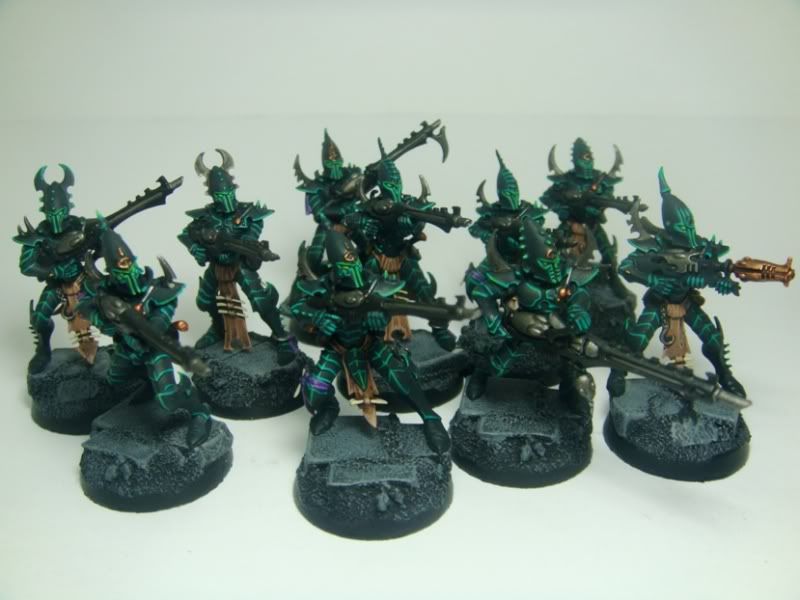So we've reached the end of the Armies in 5th for Dark Eldar. From my brief looks through forums a lot of people seem to think Dark Eldar aren't as good as they could of been compared to the 'cheese' and 'OP' of Space Wolves and Imperial Guard. Frankly, I disagree with this completely and the Dark Eldar codex is one of the best GW has ever produced in terms of competitive options for a player. This doesn't mean it's good on the table-top though but I feel this does translate and I think bad DE lists are quite hard to build if you understand basic concepts of duality and redundency. With this in mind DE play quite differently from most armies. Unlike Marine armies or armies with lots of bodies, DE don't really have an attrition value and due to their paper-thin armor, they are quite vulnerable to ranged fire support and even suppression fire is dangerous against them. However, what they lack in raw statline defenses they make up for in offensive output. Point for point, Dark Eldar are one of the best offensive armies in the game and if you don't understand this about the army, you're not going to do well. This is I think one of the key misunderstandings by many who have looked down upon the new codex and will hopefully be rectified with time.
So, in the Armies in 5th posts we've looked at the general aggressive nature of Dark Eldar and how their special rules play into this. Power from Pain particularly rewards an aggressive Dark Eldar general as getting quick pain tokens makes your troops much more survivable. This rule also benefits DE against MSU style armies as pain tokens can quickly be gathered against smaller units but also exposes the units to exposing fire if done through close combat. The ability to move pain tokens around with independent characters and start the game with a certain number of tokens is an important skill to manage as it can allow for a lot of flexibility against multiple armies. It’s important to remember though Power from Pain isn’t always necessary to DE lists to be successful. Whilst obviously making any of your infantry more survivable is good, some lists aren’t designed around this concept. The same goes from combat drugs. Combat drugs is an excellent bonus for the right DE army (i.e. Wyches/Hellion based) and whilst the re-roll wounds or +1 strength drug is often your best drug for bang, every roll on the table helps your army. It’s important not to overplay or consider these concepts in your list however as relying on these rules is going to leave you in a bind when you need them the most.
We’ve also identified key concepts relating to Dark Eldar shooting and combat. DE shooting basically has built-in anti-tank and anti-infantry and have lots of options between them. A key component of DE also is the ability to pack dualistic units into nearly every slot. Whilst this sometimes comes from the 1+1 and army within an army concept (i.e. transports), very few FoC slots are wasted against any army (trip DL Ravagers are probably the biggest offender). What’s really great about this firepower for DE is it is highly mobile and can overcome the lack of S9+ weapons by out-maneuvering the enemy. Backing up this excellent across the board shooting ability against all armies is very specific combat units. Whilst DE in general are quite good in combat due to their statlines (good WS, I and A), many of their units play quite specific roles. That’s not to say DE is a specialist combat army with a tool for each job but rather their combat units are quite proficient at a specific act (i.e. Wyches = great tarpits whilst being effective torrenters). The combination of good shooting and good combat leads to many varied build options and divergent playstyles within the book.
This brings us to the next point of mobility and the glass hammer style of the DE army. A lot of the early DE speculation brought quite a few people to the assumption that DE were an army which needs to go first to win. This is complete bollocks as explained in this non-Armies in 5th article. Whilst DE are certainly fragile, they have the firepower to compensate for this and the mobility to be able to take advantage of whatever is left. Every unit in their army either has access to a fast skimmer or can move 12” on their own steam and many units also have fleet. Add in the ability for some units to go 36” and still do damage and you have the fastest army in the game. Furthermore, DE have the ability to deploy in many different ways through Duke/Retro-fire jets, normal on-table and reserves and via a webway portal. This enhances their mobile aspect as they aren’t limited to rushing blindly across the table. The combination of this speed and their offensive output allows DE armies to overcome their glass cannon nature and pick and choose their fights. With the advent of power from pain, the DE army is able to get stronger as the game goes on and whilst obviously this does not account for lost units, does off-set their fragile and costly nature.
And so we finish up with the understanding that the new DE codex is perhaps the best GW has ever produced. It provides a unique combination of competitive choices across every FoC slot, very divergent playstyles and a ton of options for the non-competitive gamer. In fact, there are very few units which are bad and most of them are the new special characters with only one or two units in the actual Dark Eldar codex needing some work to fit in. Overall, Dark Eldar are an excellent army and the full codex review will start to pop up for all of you who have been waiting for it!


